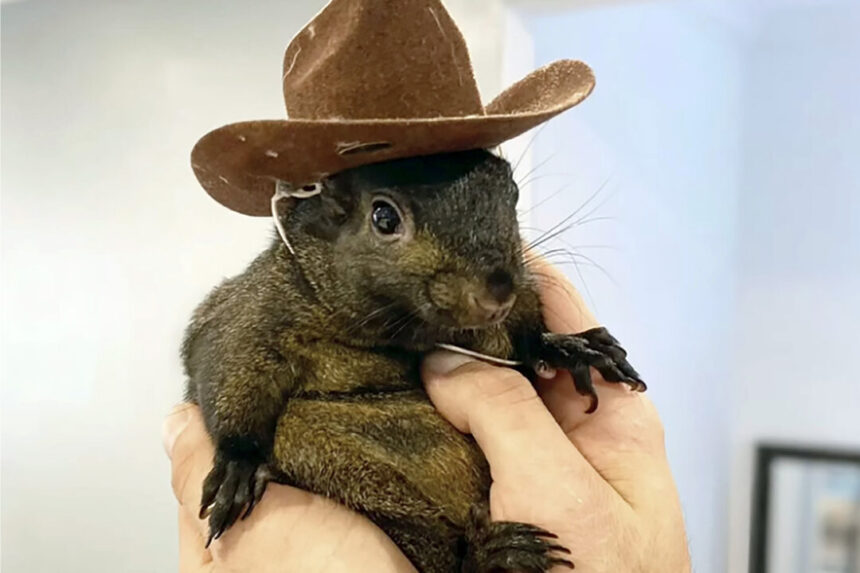Commentary
A squirrel named P’Nut was rescued as a tiny baby, nursed to adulthood, and implausibly domesticated as a house pet by a couple living in New York state. The couple took in another pet, a raccoon named Fred, who similarly became a beloved member of the household. Then, with the revenue the couple earned from social media fame, they started a licensed animal rescue service.
Alerted to their story, New York state authorities somehow obtained a warrant from a judge to search the couple’s home and seize the animals. The invasion lasted five hours and the home was torn apart as the couple was forced to wait outside. Fred and P’Nut were seized and then, shockingly, euthanized for fear of rabies, even though there was no evidence in either animal.
Surprisingly, the incident has gone viral. As they say, cometh the hour, cometh the hero. A squirrel and a raccoon have emerged as mighty symbols of the excesses of public health. A profession born a century and a half ago, with a mandate to clear the water and streets, has become a wicked hegemon imposing itself on every aspect of human life.
The story caught on with the public because it illustrates the problem with an expansive vision of the public health mandate. Once a government declares that it has arbitrary power to control infectious disease, it is implicitly claiming mastery over the entire microbial kingdom and everything in it.
More than a century ago, the same state government was on the hunt for typhoid carriers, and found a poor Irish immigrant named Mary Mallon, who was a cook. Though she carried no symptoms, cases of typhoid seemed to follow her. She was hardly the only carrier, but the drive to isolate her, take away her job, and cut her open became a fanatical campaign.
They hunted the person they called “Typhoid Mary” for many years, in a search like something out of “Les Miserables.” She ended up being forced into prison in isolation and held because she would not subject herself to the knife. There she stayed for a total of 30 years. Her name stuck and the legend persists to this day, mostly invoked as a reason why the state needs such powers.
Mary’s story came alive again in 2020 and following, during the war on a virus, a respiratory infection stemming from a lab leak that spread and mutated quickly, even to animals. Containment was impossible, but that did not stop authorities from shutting down economic life in most nations of the world.
Four and a half years later, we’ve still not had a public reckoning for what happened, even though the signs of damage are all around. Lifespans have been shortened, not because of the virus but rather because of the response, along with inflation, learning losses, and the collapse of health generally. The result was a classic case of reverse consequences: In the name of protecting health, the opposite happened.
The much-needed reckoning that has not happened is leaking out in other ways: loss of public trust in institutions, political anger and upheaval, as well as the valorization of martyrs, of whom there are many. But even with possibly millions of people injured by the COVID-19 shots, the stand-in symbol for them all has become an innocent squirrel and the right of a humane couple to show care for the little creature.
Such stories cannot be scripted. They emerge and seize the public mind in ways that defy elite intentions, and the phenomenon defies every possibility of prediction. It was this way with the Boston Tea Party as well as Rosa Parks’s refusal to sit in the back of the bus. But the phenomenon of a martyr for a cause that ends up galvanizing social change goes back to the ancient world.
The Christian calendar offers a full day of recognition of the martyrs for the faith, people who chose death over compromise with their principles. The idea here is that while we cannot bring such heroes back, we can honor their memory with public prayers of appreciation for their sacrifice. The message of All Saints Day is that civilization requires sacrifice to preserve, because there will always be worldly powers who plot the rending of the fabric of the good life. They must be resisted.
The idea of martyrdom is that martyrs are stand-ins for the rest of us. As they were treated, so too could we all be, unless change is made. It’s a mark of our times that the martyr in this case is a small squirrel. But make no mistake, P’Nut is a metaphor for how individuals have been made to feel in our times: powerless, vulnerable, and sacrificed by powers that cannot be otherwise controlled.
I’m most familiar with the interesting story of St. Cecilia, a 3rd-century Roman of high birth and wealth who converted to Christianity along with her new husband. She was hunted and captured by the authorities and sentenced to death by a steaming that she somehow survived. After that, she was beheaded but still lived three days, during which time she was said to have sung praises to God.
In the iconography and art that appeared for the next 1,500 years, she appears with a harp and music, though we have no evidence she ever played and had no musical connections in her life.
This is the essence of martyrdom: The sacrifice itself creates enduring stories that are passed down through generations, serving as timeless examples.
It is no wonder that tyrants have always feared martyrs: Their stories hold more power than any regime or weapon of a single era.
Martyrdom imparts a valuable lesson that heroic deeds transcend time, as each generation passes on the narrative to the next, becoming a part of the immortal human experience. This realization offers a new perspective on ancient myths from Greece and Rome, as well as the religions that revolve around them.
These narratives shape history, offering a meaningful way to interpret what might otherwise seem like chaotic events. Despite the modern age of “science,” we still rely on metaphors and examples that transcend the noise of daily life and political agendas.
Speaking of science, one must question how it endures as the prevailing belief system in our time, given recent events. P’Nut the squirrel was sacrificed in the name of science and public health, along with many others, and the repercussions will not be forgotten. This simple creature’s story could potentially unravel the entire scientific enterprise.
During a weekend focused on discussions about state power in various sectors, I remained unaware of the unfolding media spectacle. Upon reemerging, I discovered that popular culture had underscored the very points I had been emphasizing: the encroachment of public health measures on personal freedoms. This particular story went viral, shedding light on crucial issues in a way that no article could.
Rest in Peace, P’Nut the Squirrel and Fred the Raccoon. May their impact resonate with the masses as profoundly as it did with those who knew them.
Views expressed in this article are opinions of the author and do not necessarily reflect the views of The Epoch Times.





